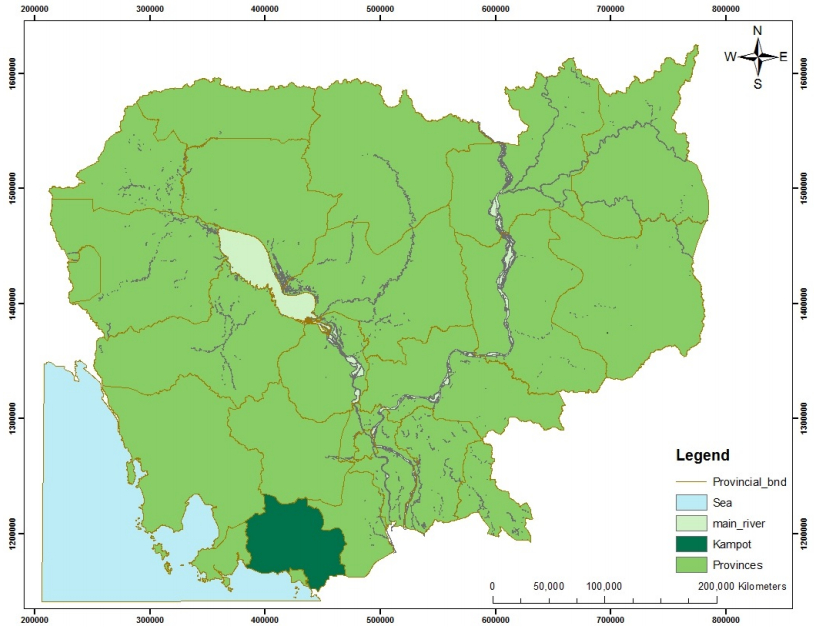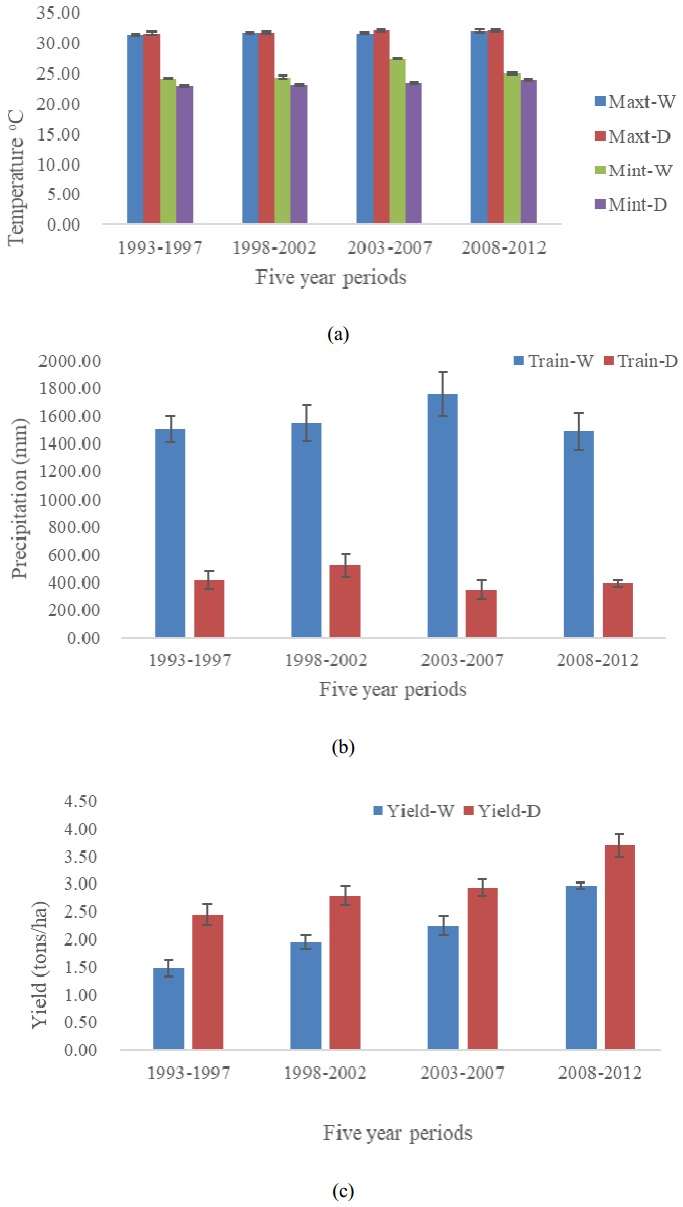Temperature and precipitation have been known as the key determinant factors to affect rice production in climate change. In this study, the relationship between climate variables and rice yields during 1993–2012 in Cambodia was analyzed and evaluated. The Ordinary Least Squares analysis was applied to examine the relationship of three climate variables (TCV) including maximum temperature, minimum temperature and rainfall against seasonal rice yields. By this period, a remarkable increasing trend of annual temperature was observed whilst rainfall was not significantly changed. The TCV explains approximately 63% and 56% of the variability of rice yields in wet and dry seasons, respectively. It is found that in Cambodia, non-climate factors such as fertilizers, water, cultivars, and soil fertility cause 40% variation to rice yields, whereas the remaining 60% can be influenced by climate variability. The levels of temperature difference (LTD) between maximum and minimum temperatures of the wet season (WS) and dry season (DS) were 7.0 and 8.6 oC, respectively. The lower value of LTD may cause the reduction of rice in WS (2.2 tons/ha) as compared to that of DS (3.0 tons/ha). Rice yield has increased 50.5% and 33.8% in DS and WS, respectively, may due to the improvement of rice cultivation practices in Cambodia such as the better use of fertilizers, pest and weed control, and irrigation, and more effective rice cultivated protocol, as the increased trend of temperature may detrimentally affect rice yield. The breeding of heat and drought tolerance rice varieties and development of irrigation system are effective to reduce the negative influence from climate change to rice production in Cambodia.
1.
Introduction
Peng [1,2] introduced seminal concepts of the sub-linear expectations space to study the uncertainty in probability. The works of Peng [1,2] stimulate many scholars to investigate the results under sub-linear expectations space, extending those in classic probability space. Zhang [3,4] got exponential inequalities and Rosenthal's inequality under sub-linear expectations. For more limit theorems under sub-linear expectations, the readers could refer to Zhang [5], Xu and Zhang [6,7], Wu and Jiang [8], Zhang and Lin [9], Zhong and Wu [10], Chen [11], Chen and Wu [12], Zhang [13], Hu et al. [14], Gao and Xu [15], Kuczmaszewska [16], Xu and Cheng [17,18,19], Xu et al. [20] and references therein.
In probability space, Shen et al. [21] obtained equivalent conditions of complete convergence and complete moment convergence for extended negatively dependent random variables. For references on complete moment convergence and complete convergence in probability space, the reader could refer to Hsu and Robbins [22], Chow [23], Ko [24], Meng et al. [25], Hosseini and Nezakati [26], Meng et al. [27] and refercences therein. Inspired by the work of Shen et al. [21], we try to investigate complete convergence and complete moment convergence for negatively dependent (ND) random variables under sub-linear expectations, and the Marcinkiewicz-Zygmund type result for ND random variables under sub-linear expectations, which complements the relevant results in Shen et al. [21].
Recently, Srivastava et al. [28] introduced and studied comcept of statistical probability convergence. Srivastava et al. [29] investigated the relevant results of statistical probability convergence via deferred Nörlund summability mean. For more recent works, the interested reader could refer to Srivastava et al. [30,31,32], Paikary et al. [33] and references therein. We conjecture the relevant notions and results of statistical probability convergence could be extended to that under sub-linear expectation.
We organize the remainders of this article as follows. We cite relevant basic notions, concepts and properties, and present relevant lemmas under sub-linear expectations in Section 2. In Section 3, we give our main results, Theorems 3.1 and 3.2, the proofs of which are given in Section 4.
2.
Preliminary
In this article, we use notions as in the works by Peng [2], Zhang [4]. Suppose that (Ω,F) is a given measurable space. Assume that H is a collection of all random variables on (Ω,F) satisfying φ(X1,⋯,Xn)∈H for X1,⋯,Xn∈H, and each φ∈Cl,Lip(Rn), where Cl,Lip(Rn) represents the space of φ fulfilling
for some C>0, m∈N relying on φ.
Definition 2.1. A sub-linear expectation E on H is a functional E:H↦ˉR:=[−∞,∞] fulfilling the following: for every X,Y∈H,
(a) X≥Y yields E[X]≥E[Y];
(b) E[c]=c, ∀c∈R;
(c) E[λX]=λE[X], ∀λ≥0;
(d) E[X+Y]≤E[X]+E[Y] whenever E[X]+E[Y] is not of the form ∞−∞ or −∞+∞.
We name a set function V:F↦[0,1] a capacity if
(a)V(∅)=0, V(Ω)=1;
(b)V(A)≤V(B), A⊂B, A,B∈F.
Moreover, if V is continuous, then V obey
(c) An↑A concludes V(An)↑V(A);
(d) An↓A concludes V(An)↓V(A).
V is named to be sub-additive when V(A+B)≤V(A)+V(B), A,B∈F.
Under the sub-linear expectation space (Ω,H,E), set V(A):=inf{E[ξ]:IA≤ξ,ξ∈H}, ∀A∈F (cf. Zhang [3,4,9,13], Chen and Wu [12], Xu et al. [20]). V is a sub-additive capacity. Set
By Definition 4.2 and Lemma 4.3 of Zhang [34], if E=E is linear expectation, V∗ coincide with the probability measure introduced by the linear expectation E. As in Zhang [3], V∗ is countably sub-additive, V∗(A)≤V(A). Hence, in Theorem 3.1, Corollary 3.1, V could be replaced by V∗, implying that the results here could be considered as natural extensions of the corresponding ones in classic probability space. Write
Assume X=(X1,⋯,Xm), Xi∈H and Y=(Y1,⋯,Yn), Yi∈H are two random vectors on (Ω,H,E). Y is called to be negatively dependent to X, if for ψ1 on Cl,Lip(Rm), ψ2 on Cl,Lip(Rn), we have E[ψ1(X)ψ2(Y)]≤E[ψ1(X)]E[ψ2(Y)] whenever ψ1(X)≥0, E[ψ2(Y)]≥0, E[|ψ1(X)ψ2(Y)|]<∞, E[|ψ1(X)|]<∞, E[|ψ2(Y)|]<∞, and either ψ1 and ψ2 are coordinatewise nondecreasing or ψ1 and ψ2 are coordinatewise nonincreasing (cf. Definition 2.3 of Zhang [3], Definition 1.5 of Zhang [4]).
{Xn}∞n=1 is called to be negatively dependent, if Xn+1 is negatively dependent to (X1,⋯,Xn) for each n≥1. The existence of negatively dependent random variables {Xn}∞n=1 under sub-linear expectations could be yielded by Example 1.6 of Zhang [4] and Kolmogorov's existence theorem in classic probabililty space. We below give an concrete example.
Example 2.1. Let P={Q1,Q2} be a family of probability measures on (Ω,F). Suppose that {Xn}∞n=1 are independent, identically distributed under each Qi, i=1,2 with Q1(X1=−1)=Q1(X1=1)=1/2, Q2(X1=−1)=1. Define E[ξ]=supQ∈PEQ[ξ], for each random variable ξ. Here E[⋅] is a sub-linear expectation. By the discussion of Example 1.6 of Zhang [4], we see that {Xn}∞n=1 are negatively dependent random variables under E.
Assume that X1 and X2 are two n-dimensional random vectors in sub-linear expectation spaces (Ω1,H1,E1) and (Ω2,H2,E2) repectively. They are named identically distributed if for every ψ∈Cl,Lip(Rn),
{Xn}∞n=1 is called to be identically distributed if for every i≥1, Xi and X1 are identically distributed.
In this article we assume that E is countably sub-additive, i.e., E(X)≤∑∞n=1E(Xn) could be implied by X≤∑∞n=1Xn, X,Xn∈H, and X≥0, Xn≥0, n=1,2,…. Write Sn=∑ni=1Xi, n≥1. Let C denote a positive constant which may vary in different occasions. I(A) or IA represent the indicator function of A. The notion ax≈bx means that there exist two positive constants C1, C2 such that C1|bx|≤|ax|≤C2|bx|.
As in Zhang [4], by definition, if X1,X2,…,Xn are negatively dependent random variables and f1, f2,…,fn are all non increasing (or non decreasing) functions, then f1(X1), f2(X2),…,fn(Xn) are still negatively dependent random variables.
We cite the useful inequalities under sub-linear expectations.
Lemma 2.1. (See Lemma 4.5 (III) of Zhang [3]) If E is countably sub-additive under (Ω,H,E), then for X∈H,
Lemma 2.2. (See Lemmas 2.3, 2.4 of Xu et al. [20] and Theorem 2.1 of Zhang [4]) Assume that p≥1 and {Xn;n≥1} is a sequence of negatively dependent random varables under (Ω,H,E). Then there exists a positive constant C=C(p) relying on p such that
Lemma 2.3. Assume that X∈H, α>0, γ>0, CV(|X|α)<∞. Then there exists a positive constant C relying on α,γ such that
Proof. By the method of substitution of definite integral, letting γy=z1/α, we get
Lemma 2.4. Let Yn,Zn∈H. Then for any q>1, ε>0 and a>0,
Proof. By Markov' inequality under sub-linear expectations, Lemma 2.1, and the similar proof of Lemma 2.4 of Sung [35], we could finish the proof. Hence, the proof is omitted here.
3.
Main results
Our main results are below.
Theorem 3.1. Suppose α>12 and αp>1. Assume that {Xn,n≥1} is a sequence of negatively dependent random variables, and for each n≥1, Xn is identically distributed as X under sub-linear expectation space (Ω,H,E). Moreover, assume E(X)=E(−X)=0 if p≥1. Suppose CV(|X|p)<∞. Then for all ε>0,
Remark 3.1. By Example 2.1, the assumption E(X)=E(−X)=0 if p≥1 in Theorem 3.1 can not be weakened to E(X)=0 if p≥1. In fact, in the case of Example 2.1, if 12<α≤1, αp>1, then for any 0<ε<1,
which implies that Theorems 3.1, 3.2, Corollary 3.1 do not hold. However, by Example 1.6 of Zhang [4], the assumptions of Theorem 3.3, Corollary 3.2 hold for random variables in Example 2.1, hence Theorem 3.3, Corollary 3.2 are valid in this example.
By Theorem 3.1, we could get the Marcinkiewicz-Zygmund strong law of large numbers for negatively dependent random variables under sub-linear expectations below.
Corollary 3.1. Let α>12 and αp>1. Assume that under sub-linear expectation space (Ω,H,E), {Xn} is a sequence of negatively dependent random variables and for each n, Xn is identically distributed as X. Moreover, assume E(X)=E(−X)=0 if p≥1. Assume that V induced by E is countably sub-additive. Suppose CV{|X|p}<∞. Then
Theorem 3.2. If the assumptions of Theorem 3.1 hold for p≥1 and CV{|X|plogθ|X|}<∞ for some θ>max{αp−1α−12,p}, then for any ε>0,
By the similar proof of Theorem 3.1, with Theorem 2.1 (b) for negative dependent random variables of Zhang [4] (cf. the proof of Theorem 2.1 (c) there) in place of Lemma 2.2 here, we could obtain the following result.
Theorem 3.3. Suppose α>12, p≥1, and αp>1. Assume that Xk is negatively dependent to (Xk+1,…,Xn), for each k=1,…,n, n≥1. Suppose for each n, Xn is identically distributed as X under sub-linear expectation space (Ω,H,E). Suppose CV(|X|p)<∞. Then for all ε>0,
By the similar proof of Corollary 3.1, with Theorem 3.3 in place of Theorem 3.1, we get the following result.
Corollary 3.2. Let α>12, p≥1, and αp>1. Assume that Xk is negatively dependent to (Xk+1,…,Xn), for each k=1,…,n, n≥1. Suppose for each n, Xn is identically distributed as X under sub-linear expectation space (Ω,H,E). Assume that V induced by E is countably sub-additive. Suppose CV{|X|p}<∞. Then
By the similar proof of Theorem 3.1 and Corollary 3.1, and adapting the proof of (4.10), we could obtain the following result.
Corollary 3.3. Suppose α>1 and p≥1. Assume that {Xn,n≥1} is a sequence of negatively dependent random variables, and for each n≥1, Xn is identically distributed as X under sub-linear expectation space (Ω,H,E). Suppose CV(|X|p)<∞. Then for all ε>0,
Moreover assume that V induced by E is countably sub-additive. Then
By the discussion below Definition 4.1 of Zhang [34], and Corollary 3.2, we conjecture the following.
Conjecture 3.1. Suppose 12<α≤1 and αp>1. Assume that {Xn,n≥1} is a sequence of negatively dependent random variables, and for each n≥1, Xn is identically distributed as X under sub-linear expectation space (Ω,H,E). Assume that V induced by E is continuous. Suppose CV{|X|p}<∞. Then
4.
Proofs of main results, Theorems 3.1, 3.2, Corollary 3.1
Proof of Theorem 3.1. We investigate the following cases.
Case 1. 0<p<1.
For fixed n≥1, for 1≤i≤n, write
Observing that Xi=Yni+Zni, we see that for all ε>0,
By Markov's inequality under sub-linear expectations, Cr inequality, and Lemmas 2.1, 2.3, we conclude that
and
Therefore, by (4.1)–(4.3), we deduce that (3.1) holds.
Case 2. p≥1.
Observing that αp>1, we choose a suitable q such that 1αp<q<1. For fixed n≥1, for 1≤i≤n, write
and X(1)n, X(2)n, X(3)n is defined as X(1)ni, X(2)ni, X(3)ni only with X in place of Xi above. Observing that ∑ji=1Xi=∑ji=1X(1)ni+∑ji=1X(2)ni+∑ji=1X(3)ni, for 1≤j≤n, we see that for all ε>0,
Therefore, to establish (3.1), it is enough to prove that II1<∞, II2<∞, II3<∞.
For II1, we first establish that
By E(X)=0, Markov's inequality under sub-linear expectations, Lemma 2.1, we conclude that
which results in (4.5) by CV{|X|p}<∞ and 1/(αp)<q<1. Thus, from (4.5), it follows that
For fixed n≥1, we note that {X(1)ni−EX(1)ni,1≤i≤n} are negatively dependent random variables. By (4.6), Markov's inequality under sub-linear expectations, and Lemma 2.2, we see that for any β≥2,
Taking β>max{αp−1α−1/2,2,p,αp−1αqp−αq+α−1}, we obtain
and
By Cr inequality, Markov's inequality under sub-linear expectations, Lemma 2.1, we see that
and
Therefore, combining (4.7)–(4.10) results in II1<∞.
Next, we will establish that II2<∞. Let gμ(x) be a non-increasing Lipschitz function such that I{x≤μ}≤gμ(x)≤I{x≤1}, μ∈(0,1). Obviously, I{x>μ}>1−gμ(x)>I{x>1}. For fixed n≥1, for 1≤i≤n, write
and
We see that
which results in
By CV{|X|p}<∞, we conclude that
Observing that 1αp<q<1, from the definition of X(2)ni, follows that
By X(4)ni>0, (4.11)–(4.13), we see that
For fixed n≥1, we know that {X(4)ni−EX(4)ni,1≤i≤n} are negatively dependent random variables under sub-linear expectations. By Markov's inequality under sub-linear expectations, Cr-inequality, Lemma 2.2, we obtain
By Cr inequality, Lemma 2.3, we have
As in the proof of (4.9) and (4.16), we can deduce that II22<∞.
By Lemma 2.1, we see that
By (4.15)–(4.17), we deduce that II2<∞.
As in the proof of II2<∞, we also can obtain II3<∞. Therefore, combining (4.5), II1<∞, II2<∞, and II3<∞ results in (3.1). This finishes the proof.
Proof of Corollary 3.1. By CV{|X|p}<∞, and Theorem 3.1, we deduce that for all ε>0,
By (4.18), we conclude that for any ε>0,
which, combined with Borel-Cantell lemma under sub-linear expectations, yields that
For all positive integers n, ∃ a positive integer k satisfying 2k−1≤n<2k, we see that
which yields (3.2). This completes the proof.
Proof of Theorem 3.2. For fixed n≥1, for 1≤i≤n, write
and
From Lemma 2.4 follows that for any β>1,
Noticing that Zn≤(|X|−nα)I(|X|>nα)≤|X|I(|X|>nα), by Lemma 2.3, we see that
Now, we will establish III1<∞. Observing that θ>p≥1, we can choose β=θ. We analysize the following two cases.
Case 1. 1<θ≤2. From (2.2) of Lemma 2.2, Lemma 2.1, E(Y)=E(−Y)=0, and Markov's inequality under sub-linear expectations follows that
Case 2. θ>2. Observe that θ>αp−1α−12, we conclude that αp−2−αθ+θ2<−1. As in the proof of (4.22), by Lemma 2.2, and Cr inequality, we see that
By Lemma 2.3, we see that
By Lemma 2.1, we deduce that
And the proof of III13<∞ is similar to that of (4.22). This finishes the proof.
5.
Conclusions
We have obtained new results about complete convergence and complete moment convergence for maximum partial sums of negatively dependent random variables under sub-linear expectations. Results obtained in our article extend those for negatively dependent random variables under classical probability space, and Theorems 3.1, 3.2 here are different from Theorems 3.1, 3.2 of Xu et al. [20], and the former can not be deduced from the latter. Corollary 3.1 complements Theorem 3.1 in Zhang [9] in the case p≥2, Corollaries 3.2, 3.3 complement Theorem 3.3 in Zhang [4] in the case p>1 in some sense.
Acknowledgments
This study was supported by Science and Technology Research Project of Jiangxi Provincial Department of Education of China (No. GJJ2201041), Academic Achievement Re-cultivation Project of Jingdezhen Ceramic University (No. 215/20506135), Doctoral Scientific Research Starting Foundation of Jingdezhen Ceramic University (No. 102/01003002031).
Conflict of interest
All authors state no conflicts of interest in this article.















 DownLoad:
DownLoad: